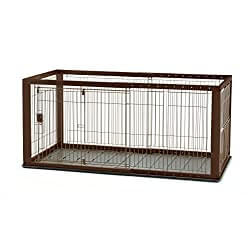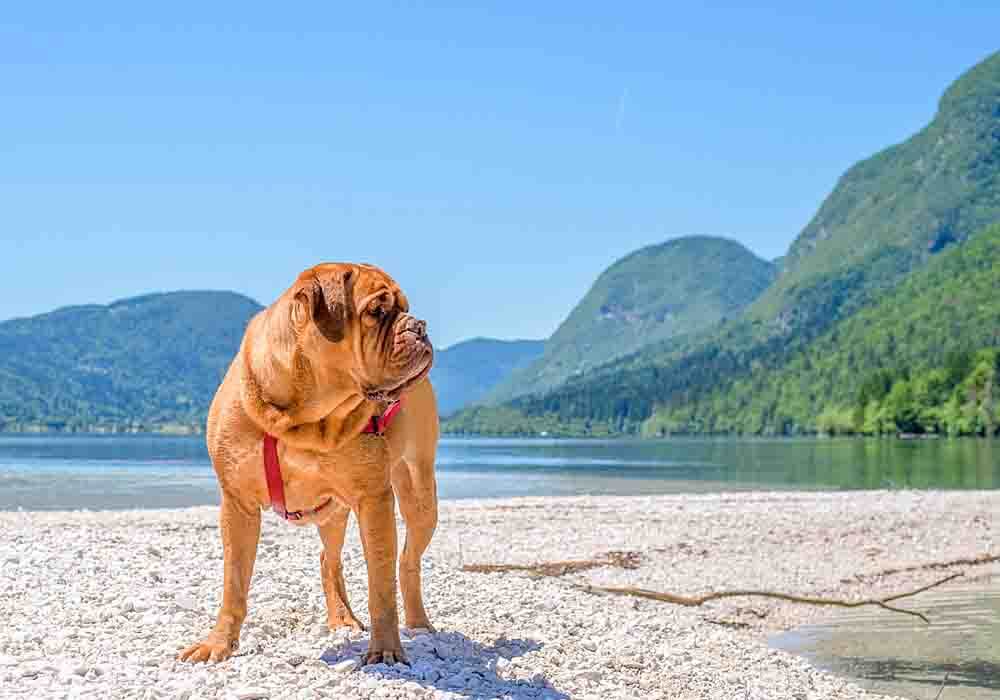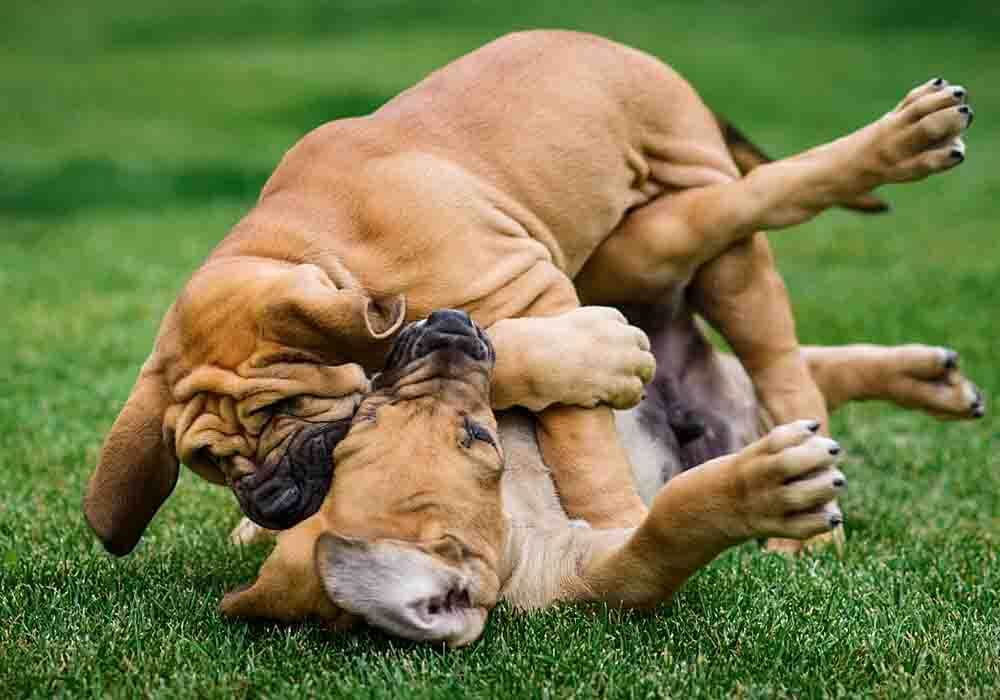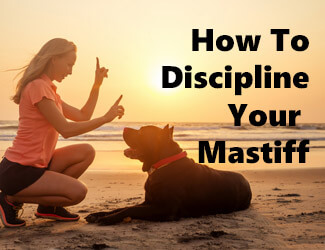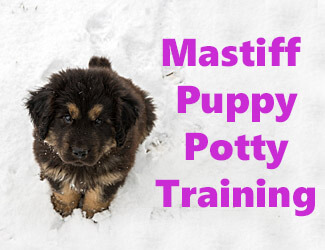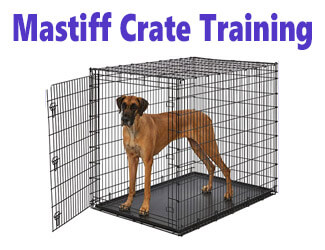Mastiff Training Tips
Stop Jumping, Biting and Chewing
by Ken Alden
Have you just brought home your
young Mastiff puppy and are now wondering how you’re going to train him?
Although you might love your drooling puppy now, the last thing you want is a
90kg (198 lbs) adult Mastiff pulling you along on your outings or jumping on
any guest.
Mastiff Training Tips...
Jumping, biting, and chewing are habits a Mastiff develops during it's early years or following erroneous rewarding. To inhibit this, owners should implement these Mastiff training tips:
- Avoid responding with attention
- Offering a chewing toy
- Implement contact-free games
- Reward positive responses
The task of training a puppy -
any breed’s puppy - can be disheartening at times, especially after another
puddle on your carpet. However, the bouncing attitude of your pup will make the
whole experience much more exciting and rewarding. Let’s find out what you need
to know to train your Mastiff. Don’t forget when going over these Mastiff training tips that positive reinforcement goes a
long way! Read More Below...
Pro-tip: Ever try lifting a Mastiff? Their weight can hurt not only your back but their joints when they hop down from cars, sofas or even your bed. To protect your back and theirs check out the best Mastiff ramps on Amazon.com now.
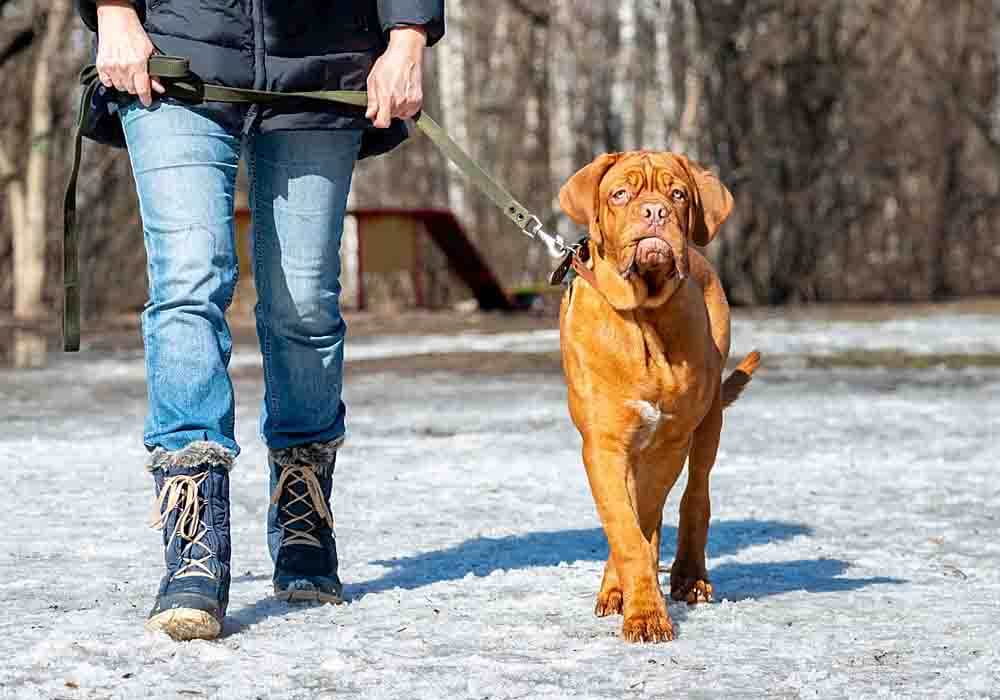
Are Mastiffs Hard Or Easy To Train?
Yes, a drooling, huge Mastiff
running straight at you can make him seem like the scariest creature on Earth.
And, if not appropriately trained, they might even be! As females can reach a
weight of 80kg (176 lbs) and males can weigh over 100kg (220 lbs), you
have good reason to think that a poorly behaved Mastiff can easily overcome a
person.
However,
their kind and loving temperament make them one of the best giant breeds of dogs for apartment
living or to introduce to a family with children. Mastiffs have been a
trustworthy companion for humans for millennia, and in turn, we have learned to
treat them with respect and love.
Despite their size, a Mastiff’s loyal attitude makes them more enjoyable to train than many other dog breeds. Yet there are some physical and psychological characteristics that you need to be aware of when starting their training:
- The Mastiff’s instincts are those of a guard dog - Without training, their protective attitude can be dangerous for both your family and strangers. Therefore, their training should focus on obedience rather than guarding.
- Mastiffs are incredibly sensitive dogs - Using negative reinforcement during training can be not only ineffective but also detrimental for your relationship with your pooch.
- You should treat your Mastiff with respect. - Mastiffs who experience aggressiveness are likely to react similarly towards you or your family during their adult life.
- Mastiffs are stubborn - Mastiffs can be quite lazy. Convincing them to repeat a task over and over might not go down as well as you think it would. For the best results, try to keep the training sessions short (only 10 to 15 minutes long).
- Mastiffs should understand that you have control - The Mastiffs’ personality makes them natural pack leaders. While you need to make clear since the first moment that you are in control, you can train them with confidence and in a calm manner.
- Mastiffs’ bones and joints are delicate - Of course, you probably don’t want a 90kg (198 lbs) Mastiff
jumping around in the house, as this can cause damage to items and people.
However, there is another reason that makes appropriate training essential:
these giant dogs’ bones and joints are prone to health issues.
Although behaviors such as
mouthing and chewing can look cute while your Mastiff is still a puppy, the
teeth and strength of an adult dog can turn those behaviors into menacing
threats.
If you
start training your Mastiff from a young age, you will see improvements in
their aggressiveness straight away. However, if you have adopted an older
Mastiff from a shelter, you should check the background of the dog, as well as
records of any previous training. A dog that has been rewarded for jumping or
biting can be hard to recondition.
Pro-tip: Mastiff anxiety, aggression, destructive chewing, jumping up, fearfulness, and other behaviors can be controlled with the right training program.
Here’s a great course that
addresses these issues along with many other dog training basics: Check it out now!
When Should I Start Training My Mastiff?
Independent of their breed,
puppies should stay with their mother and littermates for the first 8 to 10 weeks of their life. This period is significant for the formation and education of
puppies. Socializing with their mother and siblings allows puppies to
understand the essential dynamics between dogs and the right way to interact
with humans. mastiff training tips
These
social skills are the base on which to build proper development and training.
Separating a puppy from their littermates and mother can cause a shock that
most puppies struggle to overcome. Most aggression problems, such as barking,
biting, and nervous behavior originate within the first weeks of a puppy’s life.
For Mastiff puppies, creating such strong social foundations is especially important. Mastiffs tend to display mouthing behavior, even if they are properly socialized. If they are not, it is common for them not to be able to understand their potential as a human companion. In turn, they might not fully master the art of interacting with other dogs and people.
The training of a Mastiff begins among its littermates. However, once home, the task of turning an inexperienced puppy into a well-behaved dog is all yours. Before starting with a daily routine to teach your puppy all the right manners, remember that they might need time to acclimatize to the new home.
While it might be frustrating having to clean several paddles from the carpet and see your favorite couch getting shredded, it is essential for puppies to feel safe in your house. Remember that an effective training strategy is based on trust and aims at creating trust. Therefore, you should consider allowing your dog to acclimatize with the rooms in your house, the crate, the feeding station, and your garden. This process might take up to three days.
As soon as your Mastiff is ready to start a more severe learning routine, you should begin with potty training. Along with obedience training, the housebreaking process can have unexpected benefits. By taking your dog out for regular walks in social places such as a park, the puppy can start to refine his social and interaction skills.
Doing so
at such a young age allows Mastiff puppies to understand and respects physical
boundaries. This ability, in turn, will enable them to be better-behaved dogs
that won’t bark, bite, or chew as much.
Once your Mastiff puppy understands the gist of potty training, you can process with obedience exercises. These tasks can help increase your dog’s trust in you. Through positive reinforcement, you can prove that by doing what you are asking, they can enjoy a reward. Repeating such exercises will help your dog correlate obedience and happy consequences. While Mastiffs can be extremely well-behaved, you should not expect them to excel in obedience or agility training.
So you
have put all these measures in place. Yet, your puppy is still jumping around,
chewing, and, occasionally, even biting! Here there is some essential advice
for you to put in practice straight away!
How To Stop Mastiff From Jumping
There are several reasons for which you need your dog to avoid jumping. Firstly, Mastiffs are enormous dogs that can easily be dangerous for children and frail elderly citizens. If you happen to live with either your older parents or younger kids, you must get your Mastiff to stop jumping.
Secondly, while your puppy might still be in playing mode, visiting friends or family members that are strangers to your pooch might not appreciate his enthusiasm. While Mastiffs are rarely aggressive, such an attitude can make them seem intimidating and threatening. mastiff training tips
Lastly, you need to get your Mastiff to stop jumping for his benefit. Mastiffs tend to suffer from incredibly fragile bones and joints. During their growing and developing faces, Mastiff’s puppies have one of the highest tendencies to suffer from dysplasia among giant breeds. mastiff training tips
But if
your dog is not responding to your commands, how do you get him to stop jumping
at strangers and family members?
Understand why your dog is jumping
Dogs might not naturally see jumping as inappropriate behavior, but just as a way to greet a guest. In the canine world, jumping is a standard approach to meet other dogs and show playfulness.
Moreover, dogs might jump when seeking attention. This situation can happen if they ever received a reward after or because of jumping. If your Mastiff received treats after jumping, it might consider this as an acceptable behavior that can earn its rewards and, therefore, repeat it.
In the
worst scenarios, dogs might jump to confirm their dominance over family members
or visitors. Again, this behavior might be the consequence of inappropriate
rewarding and can be extremely difficult to eradicate.
Let the dog know that jumping is not accepted
If you
have never told them so, Mastiffs will not know that jumping is inappropriate.
The first step to correct this attitude is to allow the dog to understand that
jumping on strangers or family members is not permitted or tolerated.
At the
same time, you should never use negative reinforcement on a dog, especially
when dealing with Mastiffs. Firstly, ignore any undesired behavior.
Alternatively, if your Mastiff has mastered the obedience training, you could
try to use the “sit” command just before he is about to jump up.
Stop your Mastiff from jumping
Several Mastiff training tips can help you manage the jumping habit of your Mastiff. One of the most effective ones is to make clear that such behavior won’t attract attention.
Start by observing your Mastiff’s attitude as you walk through your front door. If he starts jumping in excitement, exit the door, and wait between 30 seconds and one minute outside. This period will give your dog a timeout and offer him the chance to calm down. Repeat the same strategy for as long as necessary. Finally, when your dog does not greet you by jumping anymore, you can reward a positive attitude by giving him treats and petting him.
With guests, you might
need to use a different approach. Before the guest enters the house, tether
your Mastiff to a solid structure, such as a table or tree. Let the guest
approach your Mastiff gently. If he starts jumping, ask your guest to retreat
and approach the dog again. Allow the guest to pet your dog only when he shows
a positive attitude.
Pro-tip: Mastiff's (and their owners) love dog crates…and for good reasons. Crates keep dogs from mischief while you're away, are perfect for house training, for traveling by car, and provide the dog a place to de-stress. Check out the best Mastiff crates on Amazon.com now.
How Do You Train A Mastiff Puppy Not To Bite?
Mastiff puppies have a natural high tendency to mouthing. Play-biting is a normal behavior in most puppies and an attitude essential for their healthy development. Indeed, Mastiff puppies tend to play-bite their littermates and other dogs. These bites can be painful for them, but you should not worry about them being dangerous. Yet, while biting, most puppies also tend to receive bites. This mechanism instills in them an understanding of the pain and damage that a bite can bring.
For how mainly natural this behavior can be, you also need to be able to stop it as soon as your puppies grow up. If your puppy shows a mild to medium biting attitude, you can proceed with a 3-step plan that allows you to mitigate and then gradually eliminate it firstly. However, if your puppy has a higher tendency to bite, you might consider implementing all the following techniques at once.
Especially
if your Mastiff needs reconditioning after being rehomed, you need to
understand what level of pressure you are deeming acceptable. While the force
of the bite that is tolerable depends on the breed of the dog, you should draw
the limits and understand your objectives before starting reinforcement. If the
situation calls for it, you might need to consider temporary social isolation
until your dog is improving.
Use positive reinforcement
Biting
can suggest that your dog might display aggressive behavior in the future.
While if corrected in time, puppy biting will not be a problem; don’t forget
that by training your dog through negative reinforcement, you could worsen
their hostile attitude. Instead, aim at using treats and rewards to celebrate
positive behavior. If you would like to make your dog notice a manner that you
don’t consider acceptable or tolerable, the most efficient technique is the
“silent treatment” or ignoring him for a few minutes.
Offer a timeout to your dog
If a dog is excited, he might be biting and mouthing you as a way to greet you. If you have tried the silence treatment and have not seen any result, you might consider locking your dog in a crate for a limited time, such as 5 to 10 minutes. Mastiffs love the company of their human friends and will do anything to get out of the crate. This strategy will not only give them time and space to calm down, but it might help them understand that their behavior is not acceptable.
Avoid all contact games
If your
dog has shown signs of aggressiveness or mouthing behavior before, contact
games can encourage such an attitude. Alternatively, supply them with chew
toys or smart puzzle games that can help them develop other abilities.
How To Stop Mastiff From Chewing
Your small puppy chewing on an old shoe can be funny and endearing at first. However, once your Mastiff has reached his full size, such a chewing habit has the power of destroying entire living rooms! While chewing might be a method for young dogs to explore the surrounding environment, such a practice should only apply to adequate toys.
Offer your dog a chewy toy
Mastiff puppies might seem lazy at times, but they are clever when it comes down to receiving something in exchange for a favor. They are not likely to let go of your new pair of shoes unless you can offer them a viable alternative to chew. Today, you can find specific chewing toys for large and giant breeds of dogs, which have increased resistance and lifespan. mastiff training tips
Puppy-proof your house
One of
the biggest dangers associated with the chewing habit of your puppy is that he
might ingest or lick chemicals and other hazardous substances. Avoid this risk
by puppy-proofing your house.
Use appropriate bad-tasting sprays
If you
are looking for strategies to keep your Mastiff’s giant mouth away from your
furniture, look no further than bad-tasting sprays and repellents. They only
require minimal effort from your part and can be extremely useful.
Provide your Mastiff with plenty of physical activity
Mastiffs
are known to be lazy and with a high tendency to sleep through entire days.
However, failing to provide them with enough time outdoors and practice can
increase their destructive behavior. Indeed, chewing is one of the favorite
pass-times of bored Mastiffs.
Mastiff Training Tips...Final Thoughts
Mastiffs are incredibly gentle and loving creatures that can fill your household with happiness. Yet, due to their gigantic size, a poorly trained Mastiff can become destructive, aggressive, and sometimes even dangerous.
Mastiffs are reasonably easy to train, but their development path needs to start straight after they join their new home at around eight weeks of age. Once adapted to the new environment, you should start with the potty, obedience, and agility training.
These programs will help you control the biting and chewing habits of your Mastiff, as well as improving his socialization skills. Remember that Mastiffs can be incredibly sensitive and react terribly to negative reinforcement.
Return to the top of this Mastiff Training Tips page

About the Author...
Ken Alden, a dedicated Mastiff owner for over eight years, is acclaimed for his expertise in care, grooming, and training. Read more About Me and my dog Shadow.
- Mastiff Guide Home ›
- Mastiff Training ›
- Mastiff Training Tips

